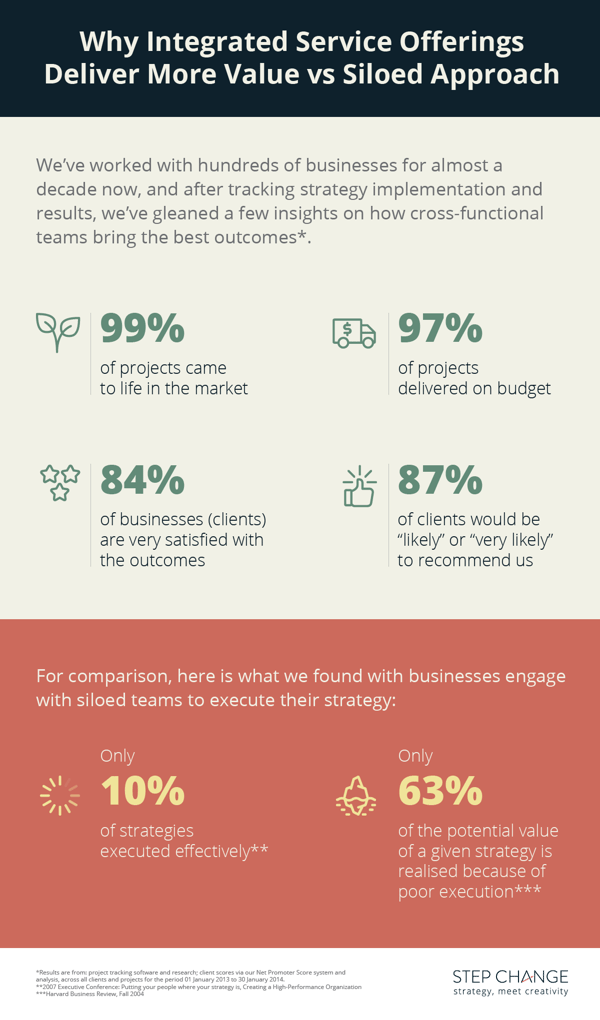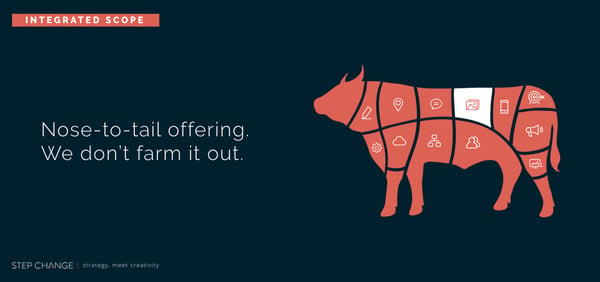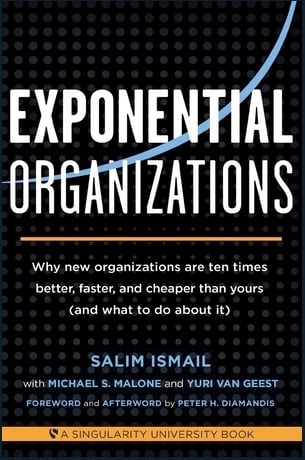UPDATED as of 03 July 2020.
Whether it’s launching a new product line, executing a brand awareness or implementing your internal comms strategy, there is one thing we know that’s certain: collaboration and integration across multiple teams are keys to get the job done and get results. But this is not always easy.
Insight: Businesses can ensure that strategy and execution are tied to business goals through seamless collaboration.
Data: In an integration study by Google, researchers found a “1.5x improvement in campaign performance when creative strategies and design are aligned to media, compared to when creative is built in a silo”.
Key Action Point: Learn how cross-functional teams and integrated service offerings can better execute the strategy from the boardroom to the field.
Individuals or specialist agencies traditionally work on a single element on their own due to the fragmented marketing landscape. In effect, business opportunities and solutions do not neatly fit within their specific service line or skill set.
If you have a challenge you need to overcome or an opportunity you want to take advantage of, having a cross-functional team with an integrated process can be your true competitive advantage.
Key Trends that Drive the Future of Business
In a world where businesses choose multiple specialist agencies instead of one integrated team, and we are suggesting that they changed that, what has changed? Here’s what we’re seeing.
Less Attention, More Choices: Consumers Are Overwhelmed More than Ever
In Australia, an average person is exposed to 3,000 branded messages a day. Whether or not a person’s attention span is shorter than that of a goldfish, the fact that many brands are competing for your audiences and customers’ attention remains, and that breaks their focus.
Scrolling speeds are increasing and consumer interactions with brands are shortening. To win the hearts of their target customers, businesses need to break through the noise and stand out.
Competition in Virtually All Categories Has Increased
Competition can be good as it creates more awareness for the product or service offering. However, the degree of competition between local and foreign companies has increased nowadays.
The top driving factors for this increased rivalry is technology, the economy, (for local businesses) ease of entry for foreign players, low differentiation, and high opportunity in the market.
Media Channels and Media Spend Have Become More Fragmented
With technology disrupting current business models as consumers change their preferences in consuming information, it’s no wonder how quickly media has evolved to match this pace.
Decades ago there were a few media channels to choose from (e.g. print and broadcast), today, disruptive technologies are making it possible for media to be fragmented into various channels and segments.
This leaves marketers with the challenge of identifying the best way to reach various target audiences at multiple touchpoints that will deliver the most return on media spend.
Customer Journeys Are More Complex
Marketers believed that customer conversion paths are linear — that prospects simply go through your ‘very organised’ path to purchase. In reality, they don’t go from stage 1 to stage 2 to stage 3 as we’d expect them to go.
Research from McKinsey & Company reveals just how messy the path to purchase is. People are different and unique, and so are their preferences, needs, and behaviour. Businesses need to see their customers as individuals and remember that the relationship with your brand will vary from person to person.
Consumers Have More Power and Ability to Research and Share of Mind
The consumer behaviour is evolving. Before making a purchase in a store or online, customers conduct an online research, read reviews and testimonials, and visit the brand’s websites. It’s the new norm businesses need to embrace: customers would research the product online and shop offline.
Cross-Functional Teams Provide Better Results
Given the kind of world we are operating in, siloed teams don’t stand a chance. When there’s a lack of coordination and communication between your departments or your partner agencies, your customer-facing messages become inconsistent, and your target buyers will know something is off.
That’s a huge step backwards from boosting your campaign’s ROI.
In any strategy and execution phase, we achieve better results if we can get the best person and tool for the job and ensure integration and collaborative work between them. This is what cross-functional, or diverse, teams deliver. A highly effective cross-functional team outperforms a team that isn’t.
Cross-functional teams are often diverse in skill and knowledge. Diverse perspectives create a space for fresh insights, innovative ideas, and creative solutions.
More important than just skill diversity is diversity in terms of gender, culture, and ethnicity. Having a diverse team brings out the best in each member and the team as a whole, providing more value to the business and to their clients.
Harvard Business Review featured multiple studies that prove unlike-minded teams are smarter and more accurate with decision-making. The article revealed that these teams are more objective in inspecting facts, and less biased, and more innovative. Here are the highlights in that article:
- Positive outcomes on financial return. McKinsey’s 2015 report revealed that companies in “the top quartile for ethnic and racial diversity in management were 35% more likely to have financial returns above their industry mean, and those in the top quartile for gender diversity were 15% more likely to have returns above the industry mean”
- Decision-making based on hard facts. Diverse teams are able to point out more facts related to the topic in question than homogenous teams and made fewer factual errors, which tend to be corrected during group deliberation (Journal of Personality and Social Psychology)
- Organised thought process. The scientists think that diverse teams may outperform homogenous ones in decision making because they process information more carefully. Remember: Considering the perspective of an outsider may seem counterintuitive, but the payoff can be huge.
- More women, more radical ideas. Another study revealed that companies with more women were more likely to initiate forward-thinking innovations into the market in just two years (Innovation: Management, Policy & Practice)
What Happens When You Use the Wrong Tool for the Job?
In a world where brands exist and compete in an already noise-cluttered digital landscape, effective execution of strategy is imperative.
An integrated, cross-functional team ensures that your strategy is executed in a way that creates a unified and consistent experience for your target customers whenever and wherever they encounter your brand.
A highly effective execution, therefore, is a powerful integration of strategy, creativity, and digital. This is what gets businesses the maximum results they are after.
My company, Step Change, is composed of different teams and skilled individuals. Unlike-minded as we all are, we work hard with our clients so they can get the business results they aspire.

Why an Integrated, Cross-Functional Team Is Better for You
Because a cross-functional team is composed of individuals from different functional areas, everyone brings their best practices, their knowledge, and their expertise to the table.
Moreover, because they live and breathe transparency and accountability, you can be confident that you will always be up to date with what has been done.
Whilst a specialist agency or siloed team understand what they specialise in, they may not fully understand what will drive your business.
With a team that’s composed of diverse individuals (results-oriented problem-solvers, agile thinkers, business-minded creatives, and effective storysellers), you are guaranteed to get more results and more value for your investment. They are also able to build better-integrated reports for the board and manage internal stakeholder expectations.
Integrated Services: Get It Right the First Time
The key to a successful marketing campaign is having a strategy to fuel it and an A-team that works harmoniously to help you achieve your business goals.

How do we do it? We start by focusing on building an overarching strategy. We then develop marketing strategies and tactics that will get your brand to where you want it to be. To that, we then create a practical and agile marketing plan, your roadmap for targeting and retaining customers. This allows you to take control of your business, as you will then know where to focus your marketing dollars to gain great ROI.
















